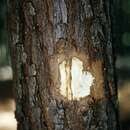Associations
provided by BioImages, the virtual fieldguide, UK
Fungus / infection vector
conidium of Amylostereum areolatum is spread by mycangial pouches of female of Sirex noctilio
In Great Britain and/or Ireland:
Foodplant / saprobe
fruitbody of Amylostereum areolatum is saprobic on old stump of Picea
Other: major host/prey
Foodplant / saprobe
fruitbody of Amylostereum areolatum is saprobic on decayed wood of Abies
Foodplant / saprobe
fruitbody of Amylostereum areolatum is saprobic on decayed wood of Fagus
Fungus / feeder
larva of Sirex noctilio feeds on wood rot imperfect state of Amylostereum areolatum
Amylostereum areolatum: Brief Summary
provided by wikipedia EN
Amylostereum areolatum is a species of crust fungus. Originally called Thelephora areolata in 1828, it was given its current name by French mycologist Jacques Boidin in 1958.
- license
- cc-by-sa-3.0
- copyright
- Wikipedia authors and editors

